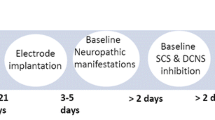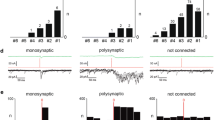Summary
We have previously reported that electrical stimulation in LC or NRM when tested on the activity of a multireceptive neurone in the spinal cord produced similar inhibitory actions. The present study aimed to define the pathways that mediate this descending inhibitory action in the spinal cord by pharmacological means and by making surgical lesions in the spinal cord or NRM. Attempts to differentiate pathways pharmacologically did not succeed since the i.v. administration of the 5-HT antagonists, methysergide and cinnanserin failed to antagonise descending inhibition evoked from either NRM or LC. Lesions involving a part or whole of the ipsilateral ventral quadrant reduced the inhibition produced from LC to a greater extent than that from NRM in 24 multireceptive neurones. In seven of these neurones stimulation in LC was without any effect after the lesion. In 23 multireceptive neurones recorded after making lesions that spared the ipsilateral ventral quadrant the effects of LC stimulation were unchanged. NRM effectiveness was reduced by an ipsilateral dorsolateral funiculus (DLF) lesion but required a bilateral DLF lesion for an almost complete abolition. Similar results were obtained when the effect of the various lesions were studied on the dorsal root potentials (DRPs) generated from LC or NRM. Lesions in the midline raphe complex, that included NRM, did not block the inhibitory action of LC stimulation. The inhibition produced from both these nuclei was additive whereas excitation was not. We conclude that LC actions in the spinal cord are mediated primarily through a pathway in the ipsilateral ventral quadrant whereas those from NRM are mediated through bilateral projections in DLF. Furthermore, although NRM plays no part in mediating LC actions and separate and independent pathways mediate their spinal action yet these apparently independent pathways have plenty of scope for interaction in the dorsal horn of the spinal cord itself.
Similar content being viewed by others
References
Amaral DG, Sinnamon HM (1977) The locus coeruleus: neurobiology of a central noradrenergic nucleus. Prog Neurobiol 9: 147–196
Barber RP, Vaughn JE, Roberts E (1982) The cytoarchitecture of GABAergic neurones in rat spinal cord. Brain Res 238: 305–328
Basbaum AI, Fields HL (1979) The origin of descending pathways in the dorsolateral funiculus of the spinal cord of the cat and rat: further studies on the anatomy of pain modulation. J Comp Neurol 187: 513–532
Basbaum AI, Fields HL (1984) Endogenous pain control systems: brainstem spinal pathways and endorphin circuitry. Ann Rev Neurosci 7: 309–338
Basbaum AI, Clanton CH, Fields HL (1978) Three bulbospinal pathways from the rostral medulla of the cat: an autoradiographic study of pain modulating systems. J Comp Neurol 178: 209–224
Belcher G, Ryall RW, Schaffner R (1978) The differential effects of 5-hydroxytryptamine, noradrenaline and raphe stimulation on nociceptive and non-nociceptive dorsal horn interneurones in the cat. Brain Res 151: 307–321
Bennet GJ, Abdelmoumene M, Hayashi H, Dubner R (1980) Physiology and morphology of substantia gelatinosa neurones intracellularly stained with horseradish peroxidase. J Comp Neurol 194: 809–827
Berman AL (1968) The brain-stem nuclei of the cat: a cytoarchitectonic atlas with stereotaxis coordinates. The University of Wisconsin Press, Wisconsin
Bowker RM, Westlund KN, Coulter JD (1981) Origins of serotonergic projections to the spinal cord in rat: an immunocytochemical-retrograde transport study. Brain Res 226: 181–199
Bowker RM, Westlund KN, Sullivan MC, Wilber JF, Coulter JD (1983) Descending serotenergic, peptidergic and cholinergic pathways from the raphe nuclei: a multiple transmitter complex. Brain Res 288: 33–48
Cervero F, Iggo A, Molony V (1979) Segmental and intersegmental organisation of neurones in the substantia gelatinosa rolandi of the cat's spinal cord. Q J Exp Physiol 64: 315–326
Charnay Y, Leger L, Dray F, Berod A, Jouvet M, Pujol JF, Dubois PM (1982) Evidence for the presence of enkephalin in catecholaminergic neurones of cat locus coeruleus. Neurosci Lett 32: 147–151
Commissiong JW (1981) Evidence that the noradrenergic coerulospinal projection decussates at the spinal level. Brain Res 212: 145–151
Commissiong JW, Hellstrom SO, Neff NH (1978) A new projection from locus coeruleus to the spinal ventral columns: histochemical and biochemical evidence. Brain Res 148: 207–213
Dahlström A, Fuxe K (1965) Evidence for the existence of monoamine neurones in the central nervous system. II. Experimentally induced changes in the intraneuronal amine levels of bulbospinal neurone systems. Act Physiol Scand (Suppl 247) 64: 1–36
Dubuisson D, Wall PD (1980) Descending influences on receptive fields and activity of single units recorded in laminae 1, 2 and 3 of cat spinal cord. Brain Res 199: 283–298
Fields HL, Basbaum AI, Clanton CH, Anderson SD (1977) Nucleus raphe magnus inhibition of spinal cord dorsal horn neurones. Brain Res 126: 441–453
Fung SJ, Barnes CD (1981) Evidence of facilitatory coeruleospinal action in lumbar motoneurones of cats. Brain Res 216: 299–311
Gerhart KD, Yezierski RP, Wilcox TK (1984) Inhibition of primate spinothalamic tract neurones by stimulation in periacqueductal gray or adjacent midbrain reticular fromation. J Neurphysiol 51: 450–465
Hancock MB, Fougerousse CL (1976) Spinal projections from the nucleus locus coeruleus and nucleus subcoeruleus in the cat and monkey as demonstrated by the retrograde transport of horseradish peroxidase. Brain Res Bull 1: 229–234
Hayes NL, Rustioni A (1981) Descending projections from brainstem and sensorimotor cortex to spinal enlargements in the cat. Exp Brain Res 41: 89–107
Hodge CJ Jr, Apkarian AV, Stevens RT, Vogelsang GD, Brown O, Frank JI (1983) Dorsolateral pontine inhibition of dorsal horn cell responses to cutaneous stimulation: lack of dependence on catecholaminergic system in the cat. J Neurophysiol 50: 1220–1235
Hökfelt T, Skirboll L, Lundberg JM, Dalsgaard CJ, Johansson D, Pernow B, Jancsó G (1983) Neuropeptides and pain pathways. In: Bonica JJ, Lindblom U, Iggo A (eds) Advances in pain research and therapy, Vol V, pp 227–246. Raven, Press New York
Hunt SP, Lovick TA (1982) The distribution of serotonin, metenkephalin and β-lipotropin-like immunoreactivity in neuronal perikarya of the cat brainstem. Neurosci Lett 30: 139–145
Hunt SP, Kelly JS, Emson PC, Kimmel JR, Miller RJ, Wu J-Y (1981) An immunohistochemical study of neuronal populations containing neuropeptides or γ-aminobutyrate within the superficial layers of the rat dorsal horn. Neuroscience 6: 1883–1898
Iggo A, McMillan JA, Mokha SS (1981) Spinal pathways for inhibition of multireceptive dorsal horn neurones by locus coeruleus and nucleus raphe magnus in the cat. J Physiol 320: 86P
Johansson O, Hökfelt T, Pernow B, Jeffcoate SL, White N, Steinbusch HWM, Verhofstad AAJ, Emson PC, Spindel E (1981) Immunohistochemical support for three putative transmitters in one neurone: co-existence of 5-hydroxytryptamine, substance P and thyrotropin releasing hormone-like immunoreactivity in medullary neurones projecting to the spinal cord. Neuroscience 6: 1857–1881
Kuypers HGJM, Maisky VA (1977) Funicular trajectories of descending brain-stem pathways in cat. Brain Res 136: 159–165
Light AR, Trevino DL, Perl ER (1979) Morphological features of functionally defined neurones in the marginal zone and substantia gelatinosa of the spinal dorsal horn. J Comp Neurol 186: 151–172
Mantyh PW (1983) Connections of midbrain periacqueductal gray in the monkey. II. Descending efferent projections. J Neurophysiol 49: 582–594
Margalit D, Segal M (1979) A pharmacological study of analgesia produced by stimulation of the nucleus locus coeruleus. Psychopharmacology 62: 169–173
Martin RF, Jordan LM, Willis WD (1978) Differential projections of cat medullary raphe neurones demonstrated by retrograde labelling following spinal cord lesions. J Comp Neurol 182: 77–88
Miletic V, Hoffert MJ, Ruda MA, Dubner R, Shigenaga Y (1984) Serotoninergic axonal contracts on identified cat spinal dorsal horn neurones and their correlation with nucleus raphe magnus stimulation. J Comp Neurol 228: 129–141
Mokha SS, McMillan JA, Iggo A (1983) Descending influences on spinal nociceptive neurones from locus coeruleus: actions, pathway, neurotransmitters and mechanisms. In: Bonica JJ, Lindblom U, Iggo A (eds) Advances in pain research and therapy, Vol V. Raven Press, New York, pp 387–392
Mokha SS, McMillan, Iggo A (1985) Descending control of spinal nociceptive transmission. Actions produced on spinal multireceptive neurones from the nuclei locus coeruleus (LC) and raphe magnus (NRM). Exp Brain Res 58: 213–226
Molony V, Steedman WM, Cervero F, Iggo A (1981) Intracellular marking of identified neurones in the superficial dorsal horn of the cat spinal cord. Q J Exp Physiol 66: 211–223
Nishikawa N, Bennet GJ, Ruda MA, Lu G-W, Dubner R (1983) Immunocytochemical evidence for a serotoninergic innervation of dorsal column postsynaptic neurones in cat and monkey: light and electron microscopic observations. Neuroscience 10: 1333–1340
Nygren L-G, Olson L (1977) A new major projection from locus coeruleus: the main source of noradrenergic nerve terminals in the ventral and dorsal columns of the spinal cord. Brain Res 132: 85–93
Peroutka SS, Snyder SH (1981) The distribution of serotonin receptors: regional variations in receptor binding in mammalian brain. Brain Res 208: 339–347
Pickel VM, Segal M, Bloom FE (1974) A radioautographic study of the efferent pathways of the nucleus locus coeruleus. J Comp Neurol 155: 15–42
Réthelyi M, Szentagothai J (1973) Distribution and connections of afferent fibres in the spinal cord. In: Iggo A (ed) Handbook of sensory physiology, Vol II Spinger, Berlin Heidelberg New York, pp 237–252
Ruda MA, Coffield J, Dubner R (1984) Demonstration of postsynaptic opioid modulation of thalamic projection neurones by the combined techniques of retrograde horseradish peroxidase and enkephalin immunocytochemistry. J Neurosci 4: 2117–2132
Sagen J, Winker MA, Proudfit HK (1983) Hypoalgesia induced by the local injection of phentolamine in the nucleus raphe magnus: blockade by depletion of spinal cord monoamines. Pain 16: 253–263
Sakai K, Sastre JP, Salvert D, Touret M, Tohyama M, Jouvet M (1979) Tegmentoreticular projectons with special reference to the muscular atonia during paradoxical sleep in the cat: a HRP study. Brain Res 176: 233–254
Satoh K, Tohyama M, Yamamoto K, Sakumoto T, Shimizu N (1977) Noradrenaline innervation of the spinal cord studied by the horseradish peroxidase method combined with monoamine oxidase staining. Exp Brain Res 30: 175–186
Segal M (1979) Serotonergic innervation of the locus coeruleus from the dorsal raphe and its action on responses to noxious stimuli. J Physiol 286: 401–415
Todd AJ, Millar J (1983) Receptive fields and responses to ionotophoretically applied noradrenaline and 5-hydroxytryptamine of units in laminae I–III of cat dorsal horn. Brain Res 288: 159–167
Tohyama M, Sakai K, Salvert D, Touret M, Jouvet M (1979a) Spinal projections from the lower brainstem in the cat as demonstrated by the horseradish perioxidase techniques. I. Origins of the reticulospinal tracts and their funcicular trajectories. Brain Res 173: 383–403
Tohyama M, Sakai K, Touret M, Salvert D, Jouvet M (1979b) Spinal projections from the lower brainstem in the cat as demonstrated by the horseradish peroxidase technique. II. Projections from the dorsolateral pontine tegmentum and raphe nuclei. Brain Res 176: 215–231
Westlund KN, Bowker RM, Ziegler MG, Coulter JD (1983) Noradrenergic projections to the spinal cord of the rat. Brain Res 263: 15–31
Westlund KN, Bowker RM, Ziegler MG, Coulter JD (1984) Origins and terminations of descending noradrenergic projections to the spinal cord of monkey. Brain Res 292: 1–16
Westlund KN, Coulter JD (1980) Descending projections of the locus coeruleus and subcoeruleus/medial parabrachial nuclei in monkey: axonal transport studies and dopamine-β-hydroxylase immunocytochemistry. Brain Res Rev 2: 235–264
Wiklund L, Leger L, Persson M (1981) Monoamine cell distribution in the cat brainstem. A fluorescence histochemical study with quantification of indolaminergic and locus coeruleus cell groups. J Comp Neurol 203: 613–647
Willis WD (1982) Control of nociceptive transmission in the spinal cord. In: Progress in sensory physiology, Vol 3. Springer, Berlin Heidelberg New York, pp 1–159
Willis WD, Haber LH, Martin RF (1977) Inhibition of spinothalamic tract cells and interneurones by brainstem stimulation in the monkey. J Neurophysiol 40: 968–981
Yezierski R-P, Wilcox TK, Willis WD (1982) The effects of serotonin antagonists on the inhibition of primate spinothalamic tract cells produced by stimulation in nucleus raphe magnus or periacqueductal gray. J Pharmacol Exp Ther 220: 266–277
Author information
Authors and Affiliations
Rights and permissions
About this article
Cite this article
Mokha, S.S., McMillan, J.A. & Iggo, A. Pathways mediating descending control of spinal nociceptive transmission from the nuclei locus coeruleus (LC) and raphe magnus (NRM) in the cat. Exp Brain Res 61, 597–606 (1986). https://doi.org/10.1007/BF00237586
Received:
Accepted:
Issue Date:
DOI: https://doi.org/10.1007/BF00237586




